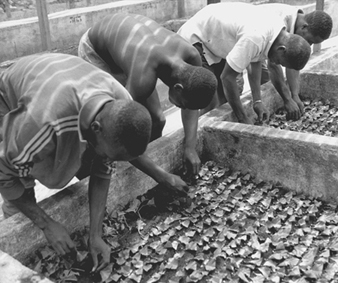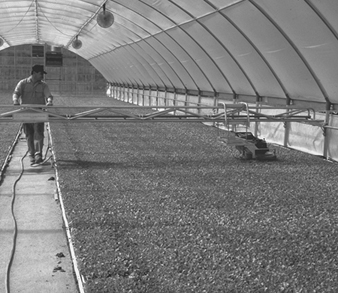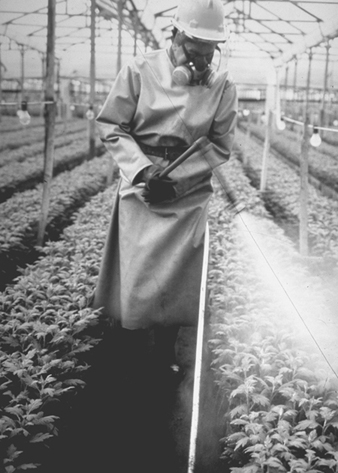Miles, John A.
Address: Department of Agricultural Engineering, University of California-Davis, Davis, California 95616
Country: United States
Phone: 1 (916) 752-6210
Fax: 1 (916) 742-2640
E-mail: jamiles@ucdavis.edu
Education: PhD,1970, Cornell University
Areas of interest: Ergonomics and design related to agricultural and forest operations
Greenhouse and Nursery Operations
The nursery industry raises plants for the replanting market (see figure 1). Hardy plants are grown outside, and the less hardy plants are propagated and raised inside, typically in greenhouses, to protect them from cold temperatures or too much solar radiation or wind. Many plants grown inside during harsh growing conditions are grown outside in favourable weather conditions. Typical nursery crops are trees and shrubs, and the typical greenhouse crops include flowers, vegetables and herbs. The nursery industry grows plants for the replanting market, but greenhouses are also used for growing crops for seasonal markets, such as tomatoes during the freezing months of winter.
Figure 1. Setting coffee plants in a nursery in Cote d’Ivoire
The plant nursery industry constitutes a large and growing sector of agriculture. In California, where there are more than 3,000 commercial nursery operations, nursery crops are a high value-per-acre commodity, ranking fifth in state farm income. As with much of western US agriculture, the employee population is dominated by workers from Mexico or other Central American countries. The majority of these workers are not migrant, but are settled in local communities with their families (Mines and Martin 1986). Most speak Spanish only or as a primary language and have little or no formal education. Wages are low for most jobs, and there is a labour surplus. Similar situations exist throughout the world.
Nursery work is considered a comparatively good job by most agricultural workers because it is year-round, comparatively well-paid and frequently includes workers’ compensation insurance and employee health benefits. Few workers belong to labour organizations in this industry, and most workers are employed directly by the enterprise rather than by farm labour contractors.
Greenhouses provide a controlled environment for plants and are used for a variety of purposes, which include growing rare and exotic plants, protecting producing plants (such as flowers, tomatoes and peppers) from winter weather and starting seedlings. The controlled environment within a greenhouse is advantageous to those who wish to grow crops year-round, regardless of seasonal conditions outdoors. Greenhouse operations have expanded in temperate climates. For example, in the Ukraine, the total area of greenhouses has grown from 3,070 hectares (ha) in 1985 to 3,200 ha in 1990 to an estimated 3,400 ha in 1995 (Viten, Krashyyuh and Ilyna 1994).
The gable (equal sloping roof) greenhouse is typical. It provides good exposure to winter sunlight, drainage and wind protection. The framing materials for greenhouses include wood, aluminium or a combination of steel pipe and wood. Side walls or siding can be made from a variety of materials including plywood, aluminium, wood or vinyl. In the Ukraine, 60% of the greenhouses have masonry block walls. Covers include glass or plastic, and in some parts of the world, the glass-covered house is called a glasshouse. The plastic can be either rigid or a flexible film. Rigid plastics used as covers include fibreglass, acrylic and polycarbonate. Flexible plastic covers include polyethylene, polyvinyl chloride and polyester. Polycarbonate, which withstands breakage from thrown objects, and the flexible plastics require frequent replacement. Covers can vary from clear to opaque, and they serve three purposes. One is to let sunlight in for the plants. Another is for heating within an enclosure. The last is protecting the plants from environmental stress, including snow, rain, hail, high winds, birds, small animals and insects.
The greenhouse operation requires the control of temperature, humidity and ventilation, using artificial heat sources, exhaust and inlet fans, shading (such as with movable slats or netting), cooling equipment (such as wet-pad or evaporative cooling), humidification and climate-control equipment (Jones 1978).
Nursery and greenhouse workers are exposed to a variety of hazards, including skin irritants, dust, noise, heat stress, musculoskeletal disorders (sprains and strains), pesticides and injuries related to vehicles, machines, slips and falls and electricity. The hazards discussed below are limited to ergonomic hazards in nursery work and pesticide hazards in greenhouse work. Many of these hazards are common for the two operations.
Nursery Operations
Typical operations at a large wholesale nursery specializing in container-grown outdoor bedding and ornamental plants consist of four stages:
- Propagation stage. New plants are started in a specialized medium using one of four standard methods: cuttings from mature plants, tissue culture, seeds and grafting.
- Replanting stage. As plants grow they are replanted into individual plastic containers called “cans” (typically 2 or 3 times during the early growth cycle). A powered conveyor carries the new, larger cans past a hopper where they are filled with soil. As the cans continue down the conveyor, plants are manually transplanted into them, and finally they are manually transferred onto a trailer for transport to the field.
- Growing stage or field operations. Plants are held in outdoor groups until fully mature. During this period, tasks include watering, pruning, fertilizing and weeding, tying-staking-shaping and spacing as plants grow.
- Shipping. Mature plants are removed to the shipping area, labelled, organized by order load, and loaded into trucks. This operation can also include truck unloading at retail sites.
Ergonomic hazards
Nursery work, as with other agricultural commodities, has a pattern of high rates of sprain and strain injuries. AgSafe data (1992) suggest that 38.9% of all reported injuries in horticultural specialties (including nurseries) were sprains and strains, slightly above the proportion for agriculture as a whole. Overexertion as a cause of injury for this area was cited for 30.2% of reported injuries, also above the proportion for the industry as a whole.
The most common risk factors for the development of work-related musculoskeletal problems have been identified as occurring in the following job tasks:
During propagation, the worker stands or sits at a work table, empties a basket of plant cuttings, and uses hand shears to cut them into smaller pieces. The shears are held in the dominant hand; plant material is grasped with the other hand. After each piece of plant material is cut, the shears must be disinfected by dipping them in a solution in a small container in the work bench.
When cutting, one hand is engaged in very repetitive gripping, with an average of 50 to 60 cuts per minute. Mild to moderate wrist flexion and ulnar deviation occur throughout the cutting cycle. The other hand is used to hold the cuttings, orient them for cutting, and discard the remains in a bin. Moderate wrist extension and ulnar deviation occur throughout this cycle also.
Workers in this specialized job are highly skilled and work virtually full-time year-round without rotation into other jobs. Workers report pain and numbness in the hand, wrist and arm. After a period of years on this job, they demonstrate an elevated incidence of carpal tunnel syndrome.
In transporting plants from a conveyor belt to a trailer, the worker grasps 3 or 4 3.8-litre containers in each hand and places them on a trailer located either to one side of or behind him or her. This job cycle is repeated 13 to 20 times per minute. Risk factors include highly repetitive gripping, high pinch forces and awkward postures, including trunk, lumbar and shoulder flexion.
In transporting plants from a trailer to a planting bed, the worker grasps 3 or 4 3.8-l containers in each hand, carries them up to 17 m, and places them on the ground along a predetermined row. This job cycle is repeated 3 to 5 times per minute. Handling cans is a nearly full-time, year-round job for many workers. It is associated with pain in the fingers and hands, upper extremities and lower back. Because field workers tend to be younger, the predicted high rate of chronic back injury is not documented at this time.
The pruner works with various shears to snip unwanted or dead parts off the tops and sides of plants. The worker is usually standing or bent over to reach plants. The dominant hand holds the shears and is engaged in very repetitive gripping, with an average of 40 to 50 cuts per minute. The fingers of the same hand are also used to pinch off small twigs or other plant parts. The nondominant hand grasps the can for a rapid pick and place, and also holds the cuttings in a static grip with a moderate wrist flexion and ulnar deviation present throughout the cutting cycle. Because pruning is a part-time task for most field workers, some relief and recovery are achieved due to task variation. However, it is associated with pain in the fingers and hand, wrist, upper extremities and lower back.
To allow plants adequate room to grow and expand, spacing must be done periodically. This entails grasping and lifting 3 to 4 plants in each hand, carrying them a short distance, and placing them on the ground in rows. This cycle is repeated 3 to 5 times per minute. Like pruning, spacing is a part-time task for most field workers, allowing opportunity for relief and recovery. It is also associated with pain in fingers and hands, wrists, upper extremities and lower back.
Most nursery jobs are human-energy intensive, and this, coupled with the repetitive nature of many tasks, leads to substantial risk of repetitive-motion injuries. Tools to assist the workers by improving body posture and reducing the energy requirements of particular tasks have just begun to be developed.
Greenhouse Operations
Typical operations in a greenhouse vary depending on whether the purpose is to grow rare and exotic plants, production plants or seedlings. The growing of rare or exotic plants is a year-round enterprise. Production plants are typically grown within the greenhouse to protect them from the weather; thus, greenhouses can be used seasonally. The growth of seedlings is similar to nursery operations, but the market is plants for spring replanting after the last freeze. The tasks involved in greenhouse growing include putting the soil into small containers, planting the seed in each of the containers, watering and fertilizing the plants, trimming or thinning the plants as needed (see figure 2), applying fumigants or pesticides and transporting the plants or product from the greenhouse. Soil filling and planting has become a mechanized operation in the production greenhouse. The composition of the potting soil may be a mix of peat, perlite and vermiculite. Trimming may be mechanized, depending upon the crop. Watering may be directly with a hose or through an automated sprinkler or piping system. Nutrients are added to the water to fertilize the plants. Application of pesticides by hand sprayer is typical. Soil sterilization is done either by steam or chemicals, including dibromochloropropane (DBCP). The transport of plants or product is typically a manual exercise.
Figure 2. Clipping (mowing) tobacco transplants in a greenhouse in North Carolina
Pesticides Used in Greenhouses
Diseases and insects that attack plants can result in major problems for greenhouse operators. Often, preventing such damage is easier than trying to eradicate the pests afterward. Some common pests that inflict the most damage on greenhouse crops are insects, fungi, viruses, bacteria and nematodes. To combat these undesirable organisms, special chemicals (pesticides) are applied to the plants to kill the pests.
There are many ways of applying pesticides so that they are effective. The most common application methods are: liquid sprays, mists, dusts, fogs, smokes, aerosol canisters and granules. Pesticide sprays involve the use of a water/pesticide mixture contained in a tank that has a hose with a spray nozzle attached to it. Under pressure, the mixture is directed onto the plants as liquid droplets. Mists are generated by a technique similar to the spray technique, but the resulting droplets are smaller. Pesticide dusts are often released into the air and allowed to settle onto the plant surface. Foggers use heating devices to generate very small droplets directed at the plants. Pesticide smokes are generated by igniting a sparkler and placing it in a canister that contains the chemical.
Aerosol canisters are pressurized metal containers that release the pesticide to the air when a valve is opened. Finally, granular pesticides are placed on top of the soil and then watered. The watering dissolves the granules and transports the chemical to the roots of the plant, where it can either kill organisms in the soil or be absorbed by the plant and kill organisms that feed on it.
With each different method of application of a pesticide comes the hazard of being exposed to the chemical. The two most common routes of exposure are through the skin (dermal) and through the lungs (respiratory). Another, but less common, route of exposure is by ingesting food or drinks contaminated with pesticides. Greenhouse workers who handle the chemicals or the treated plants may be poisoned if proper safety precautions are not followed.
Ways to avoid poisoning include proper use of greenhouse ventilation systems, using and maintaining the appropriate PPE (suits, gloves, respirators, boots—see figure 3), observing recommended re-entry times and following the pesticide label instructions. Some additional safety precautions are: storage of all pesticides inside a locked, well-ventilated area; posting signs in areas where plants have been treated; and comprehensive pesticide training that includes proper application and handling techniques. Finally, all pesticide applicators should be trained in appropriate disposal techniques for old pesticides and empty pesticide containers.
Figure 3. Worker in full protective gear applies pesticides in a greenhouse.
" DISCLAIMER: The ILO does not take responsibility for content presented on this web portal that is presented in any language other than English, which is the language used for the initial production and peer-review of original content. Certain statistics have not been updated since the production of the 4th edition of the Encyclopaedia (1998)."



